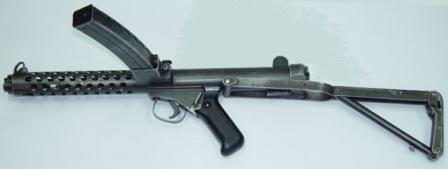Characteristics
| Sterling L2A3 | Sterling L34A1 silenced | |
| Caliber | 9x19mm Luger/Parabellum/NATO | |
| Weight, empty | 2,7 kg | 3,6 kg |
| Length (stock closed/open) | 481 / 686 mm | 660 / 864 mm |
| Barrel length | 196 mm | 196 mm |
| Rate of fire | 550 rounds per minute | 550 rounds per minute |
| Magazine capacity | 34 rounds | 34 rounds |
| Effective range | 200 meters | 50-100 meters |
The famous Sterling submachine gun was born in around 1942 as "Patchettmachine carbine"
- a prototype submachine gun, developed by George W.Patchett and
originally produced by Sterling Engineering Co in England. Several
prototypes were built before the end of the war, and the
Sterling-Patchett submachine gun participated in extensive trials, held
in UK between 1945 and 1953, when it was finally announced as a winner
of trials, and adopted as"9mm Sterling submachine gun L2A1" (factory
designation was"Patchett Mk.1"). Sterling submachine guns were produced
for British armed forces by Sterling company and Royal Ordnance
Arsenalin Fazakerly, England; Long Branch Arsenal in Canada made a
slightly modified Sterling under license for Canadian army as C1. In a
slightly modified form,known in British service as L2A3 submachine gun
or as "Sterling submachine gun, Mark 4" or Sterling Mk.4 in short, it
served with British army until early 1990s, when it was finally replaced
by troublesome L85A1 assault rifle.
Nearly 400 000 of Sterling submachine guns were produced until late
1980s. In 1967, British army adopted the L34A1 /Sterling Mk.5 silenced
submachine gun, which is apparently still in limited use with certain
special operations elements in British army.
Sterling submachine guns also were widely sold for export, more than 70 countries had purchased various quantities of Sterling submachine guns.
It must be noted that Sterling submachine guns were rather popular among British troops, because of relatively compact size, adequate firepower and acuracy andgood reliability.
Sterling submachine guns also were widely sold for export, more than 70 countries had purchased various quantities of Sterling submachine guns.
It must be noted that Sterling submachine guns were rather popular among British troops, because of relatively compact size, adequate firepower and acuracy andgood reliability.
L2A3 /Sterling Mk.4 submachine gun is blowback operated, selective
fired weapons that fires from open bolt. The fire mode selector / manual
safety lever is located on the left side of trigger unit, above the
grip panel. Tubular receiver, which also serves as a barrel jacket at
the front, contains a cylindrical bolt with fixed firing pin. Bolt body
has several spiral grooves on its outside surface which collect the dust
and fouling from inside the receiver, and thus greatly improve
reliability of the gun under field conditions. Feeding is from the left
side;magazines are inserted horizontally, and ejection is to the right.
Magazines are of slightly curved shape for improved feeding reliability.
Buttstock is made from stamped steel and folds down and below the
receiver to save space. Standard sights include protected front blade
and flip-up rear aperture sight, marked for100 and 200 yards range, and
also protected from sides by sturdy"ears".
Special "high power, submachine-gun only" ammunition was procured by British army for Sterling submachine guns. This ammunition was absolutely safe in Sterling submachine guns, but can cause extensive wear to many 9mm pistols designed for commercial 9x19 ammunition.
L34A1 /Sterling Mk.5 silenced submachine gun differed in the barrel section, as its barrel has some 72 small holes used to vent powder gases into the rear expansion chamber of the integral silencer. This was necessary to decrease the muzzle velocity of the bullet so it would be below the speed of sound. Like its predecessor, the STEN Mk.IIS, the silenced Sterling gun was intended to be fired mostly in semi-automatic mode; the full-automatic fire was for emergency purposes only.
Special "high power, submachine-gun only" ammunition was procured by British army for Sterling submachine guns. This ammunition was absolutely safe in Sterling submachine guns, but can cause extensive wear to many 9mm pistols designed for commercial 9x19 ammunition.
L34A1 /Sterling Mk.5 silenced submachine gun differed in the barrel section, as its barrel has some 72 small holes used to vent powder gases into the rear expansion chamber of the integral silencer. This was necessary to decrease the muzzle velocity of the bullet so it would be below the speed of sound. Like its predecessor, the STEN Mk.IIS, the silenced Sterling gun was intended to be fired mostly in semi-automatic mode; the full-automatic fire was for emergency purposes only.


 09.34
09.34
 Jack The Ripper
Jack The Ripper






 Posted in:
Posted in:
0 komentar:
Posting Komentar